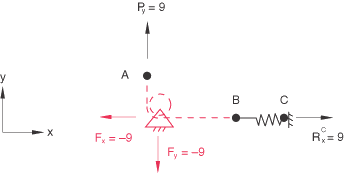Defining a Linear Constraint Equation
A linear constraint equation is defined in Abaqus by specifying:
-
the number of terms in the equation, N;
-
the nodes, P, and the degrees of freedom, i, corresponding to the nodal variables ; and
-
the coefficients, .
For example, to impose the equation
you would first write the equation in the standard form,
There are three terms in this equation (N=3). P=5, i=3, =1.0, Q=6, j=1, =−1.0, R=1000, k=3, and =1.0.
In Abaqus/Standard the first nodal variable specified ( corresponding to ) will be eliminated to impose the constraint (in the above equation constraint, degree of freedom 3 at node 5 will be eliminated); therefore, it should not be used to apply boundary conditions, nor should it be used in any subsequent multi-point constraint, kinematic coupling constraint, tie constraint, or equation constraint (see About Kinematic Constraints). In addition, the coefficient should not be set to zero. These restrictions do not apply in Abaqus/Explicit.
In Abaqus/Standard a linear multi-point constraint cannot be used to connect two rigid bodies at nodes other than the reference nodes, since multi-point constraints use degree-of-freedom elimination and the other nodes on a rigid body do not have independent degrees of freedom. In Abaqus/Explicit a rigid body reference node or any other node on a rigid body can be used in an equation constraint definition.


